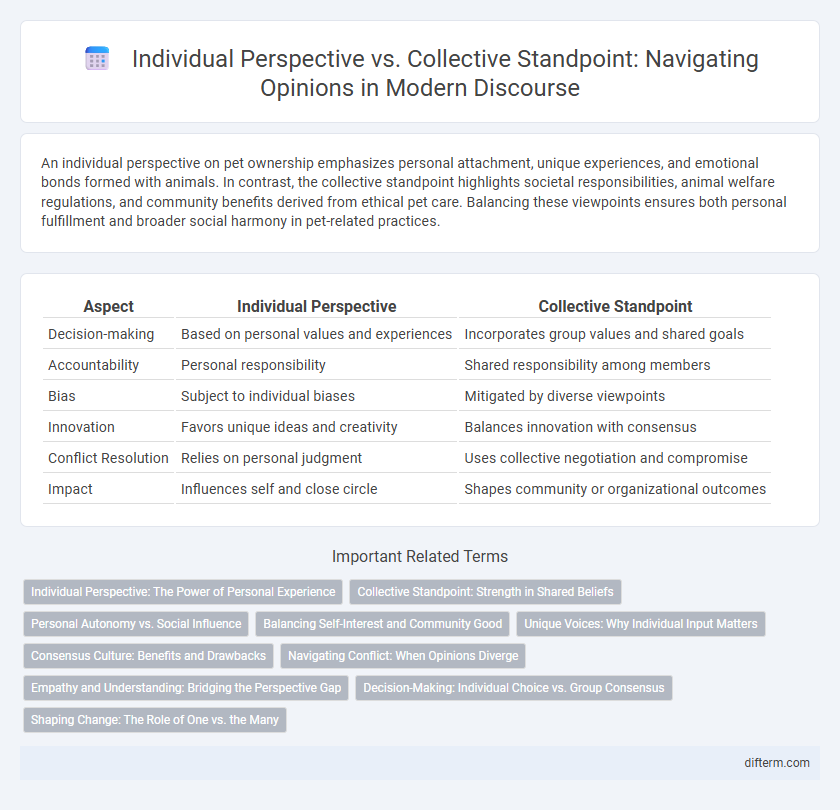An individual perspective on pet ownership emphasizes personal attachment, unique experiences, and emotional bonds formed with animals. In contrast, the collective standpoint highlights societal responsibilities, animal welfare regulations, and community benefits derived from ethical pet care. Balancing these viewpoints ensures both personal fulfillment and broader social harmony in pet-related practices.
Table of Comparison
| Aspect | Individual Perspective | Collective Standpoint |
|---|---|---|
| Decision-making | Based on personal values and experiences | Incorporates group values and shared goals |
| Accountability | Personal responsibility | Shared responsibility among members |
| Bias | Subject to individual biases | Mitigated by diverse viewpoints |
| Innovation | Favors unique ideas and creativity | Balances innovation with consensus |
| Conflict Resolution | Relies on personal judgment | Uses collective negotiation and compromise |
| Impact | Influences self and close circle | Shapes community or organizational outcomes |
Individual Perspective: The Power of Personal Experience
Individual perspective holds unique value as it is shaped by personal experiences, emotions, and beliefs that collective standpoints cannot fully encapsulate. Personal narratives provide nuanced insights and foster empathy, allowing for a deeper understanding of complex issues. Emphasizing individual viewpoints enriches dialogue and drives innovation by challenging groupthink and broadening the scope of ideas.
Collective Standpoint: Strength in Shared Beliefs
Collective standpoints harness the power of shared beliefs to foster unity and drive meaningful social change, amplifying individual voices into a cohesive force. This perspective enables communities to address systemic challenges effectively by pooling diverse experiences and resources toward common goals. Emphasizing collective agency strengthens resilience and promotes inclusive decision-making that benefits the broader society.
Personal Autonomy vs. Social Influence
Personal autonomy empowers individuals to make decisions based on their values and experiences, fostering self-expression and innovation. Social influence shapes behaviors and opinions through cultural norms and peer pressure, promoting group cohesion and shared identities. Balancing personal autonomy with social influence is essential for both individual fulfillment and societal harmony.
Balancing Self-Interest and Community Good
Balancing self-interest and community good requires recognizing that individual perspectives shape unique contributions while collective standpoints drive societal progress. Emphasizing empathy and mutual respect aligns personal goals with communal well-being, fostering cooperation without sacrificing individuality. Sustainable harmony emerges when personal ambitions are integrated thoughtfully with shared responsibilities and common values.
Unique Voices: Why Individual Input Matters
Individual perspectives offer unique insights that enrich collective understanding by introducing diverse experiences and original ideas. Emphasizing unique voices fosters innovation and prevents conformity, strengthening decision-making across communities and organizations. Recognizing the value of personal input ensures that solutions are inclusive and reflective of varied human realities.
Consensus Culture: Benefits and Drawbacks
Consensus culture fosters collaboration and unity by encouraging collective decision-making, which often leads to solutions that reflect diverse viewpoints and increase group buy-in. However, this approach can also suppress individual creativity and delay progress due to the need for widespread agreement, potentially resulting in conformity and groupthink. Balancing individual perspectives with collective goals is critical to harnessing the full benefits of consensus while minimizing its drawbacks.
Navigating Conflict: When Opinions Diverge
Navigating conflict requires understanding the interplay between individual perspective and collective standpoint, as differing opinions often stem from unique experiences and values. Emphasizing empathy and open communication bridges gaps, allowing for productive dialogue despite divergent views. Recognizing that consensus may not always be possible fosters respect and collaboration in resolving disputes.
Empathy and Understanding: Bridging the Perspective Gap
Empathy plays a crucial role in bridging the gap between individual perspectives and collective standpoints by fostering deeper understanding and shared values. Recognizing diverse experiences enhances emotional intelligence, allowing individuals to connect beyond personal biases and contribute to cohesive group dynamics. Cultivating empathy strengthens social bonds and promotes collaborative solutions in complex social environments.
Decision-Making: Individual Choice vs. Group Consensus
Individual decision-making emphasizes personal autonomy, allowing tailored choices that reflect unique values and priorities, which can lead to innovative solutions. Group consensus, however, integrates diverse perspectives, fostering comprehensive understanding and shared responsibility, often resulting in more sustainable and accepted outcomes. Balancing individual insights with collective input enhances decision quality by combining creativity with inclusivity.
Shaping Change: The Role of One vs. the Many
Individual perspectives serve as catalysts for innovation, often challenging prevailing norms and inspiring new ways of thinking. Collective standpoints provide the necessary momentum to implement widespread transformations by uniting diverse insights into a coherent strategy. Balancing the influence of one with the strength of many accelerates social progress and fosters sustainable change.
individual perspective vs collective standpoint Infographic

 difterm.com
difterm.com